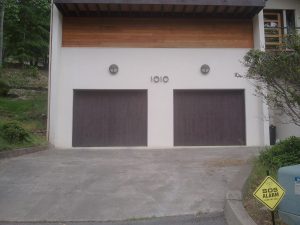
A well-maintained garage door can often last you a decade or longer. Unfortunately, this doesn’t also apply to your garage door parts. Chances are, you’ll need to replace things like screws, springs, hinges, and rollers long before you’ll need to buy a new garage door. And often, it’s worth it to do these regular garage door repairs; it keeps your door working at its best and can extend the life of the door. Keeping up on maintaining garage door parts keeps the garage door’s infrastructure balanced and its movement smooth and quiet.
But if your garage door has become particularly noisy lately, then it may be time for a garage door roller replacement. The rollers allow the garage door opener to lift and lower the door within the tracks, keeping the garage door balanced during each use. Chewed up rollers don’t move nearly as well, creating an awful noise and making the garage door opener work too hard. Not to mention that the worse condition the rollers are left in, the more likely that your garage door goes off track or out of balance.
Replacing Rollers is an Easy DIY Garage Door Repair
Replacing the rollers on your garage door is a simple task, but as with all garage door repairs, a certain level of caution should be exercised. DIY projects are great, but not when they end up in ER visits. That said, rollers really are a low-risk situation when it comes to garage door repair safety.
First, grab your supplies:
- Safety ladder
- Clamps (2)
- Wrench/socket wrench
- Rollers (we recommend nylon over metal)
- Screwdriver
- Pliers
Now, here’s how you go about replacing a roller:
- Raise your garage door and clamp both sides of the tracks about 2/3rds of the way up.
- Place a ladder underneath the raised garage door to help support it as an extra safety measure, should the clamps fail.
- Disengage the emergency release on the garage door opener. Make sure to also unplug your garage door opener to prevent operation during the repair. It may also be beneficial to have another person watch the door and your surroundings for safety.
- Slightly bend the track with a pair of pliers and lift the old rollers off the rail. R
- Remove the old rollers and install the new ones.
- Placing them back on the track and bend the rail back into its original shape to secure the new rollers in the garage door track.
- Repeat this process for the remaining rollers.
- Re-engage the emergency release to the opener and plug the garage door opener back in.
- Remove the clamps from the tracks and ladder from underneath the door.
- Try operating the door a few times and make note of any noise or unusual movement. If it works as expected, then you’ve successfully replaced the rollers!
If this didn’t fix the original problem: a noisy garage door, you may have another issue a bit harder to diagnose. In that case, call in the professionals at SACS GARAGE DOOR REPAIR to come give you a hand.
